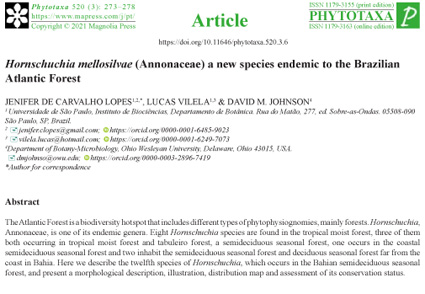Abstract
The Atlantic Forest is a biodiversity hotspot that includes different types of phytophysiognomies, mainly forests. Hornschuchia, Annonaceae, is one of its endemic genera. Eight Hornschuchia species are found in the tropical moist forest, three of them both occurring in tropical moist forest and tabuleiro forest, a semideciduous seasonal forest, one occurs in the coastal semideciduous seasonal forest and two inhabit the semideciduous seasonal forest and deciduous seasonal forest far from the coast in Bahia. Here we describe the twelfth species of Hornschuchia, which occurs in the Bahian semideciduous seasonal forest, and present a morphological description, illustration, distribution map and assessment of its conservation status.
References
<p>Chatrou, L.W., Pirie, M.D., Erkens, R.H.J., Couvreur, T.L.P., Neubig, K.M.J., Abbott, R., Mols, Maas, J.W., Saunders, R.M.K. & Chase, M.W. (2012) A new subfamilial and tribal classification of the pantropical flowering plant family Annonaceae informed by molecular phylogenetics. <em>Botanical Journal of the Linnean Society</em> 169: 5–40. https://doi.org/10.1111/j.1095-8339.2012.01235.x</p>
<p>Dantas, H.G.R., Lima, H.C. & Bohrer, C.B.A. (2009) Mapeamento da vegetação e da paisagem do Município de Armação dos Búzios, Rio de Janeiro, Brasil. <em>Rodriguésia</em> 60: 25–38. https://doi.org/10.1590/2175-7860200960102</p>
<p>Fries, R.E. (1931) <em>Hornschuchia</em>. Pp. 132–139. Revision der Arten einiger Anonaceen-Gattungen II. <em>Acta Horti Bergiani</em> 10: 129–341, taf. 1–27.</p>
<p>Galindo-Leal, C. & Câmara, I.G. (2005) Status do hotspot Mata Atlântica: uma síntese.<em> In: </em>C. Galindo-Leal & I.G. Câmara (Eds.) Mata Atlântica: biodiversidade, ameaças e perspectivas. São Paulo: Fundação SOS Mata Atlântica - Belo Horizonte: Conservação Internacional, pp. 3–12.</p>
<p>Gouvêa, J.B.S., Mattos Silva, L.A. & Hori, M. (1976) 1. Fitogeografia.<em> In: Diagnóstico Socioeconômico da Região 5 Cacaueira, Recursos Florestais</em>, vol. 7. Comissão Executiva do Plano da Lavoura Cacaueira, Instituto Interamericano de Ciências Agricolas-OEA. Ilhéus, Bahia, Brazil, pp. 1–7.</p>
<p>Hickey, L.J. (1979) A revised classification on the architecture of dicotyledonous leaves.<em> In: </em>Metcalfe, C.R. & Chalk, L. (Eds.) Anatomy of the dicotyledons, ed. 2, vol. 1. Clarendon, Oxford, pp. 25–39.</p>
<p>IUCN (2012) <em>IUCN Red List Categories and Criteria</em>. Version 3.1. Second edition. IUCN Species Survival Commission, Gland. 32 pp.</p>
<p>INSTITUTO BRASILEIRO DE GEOGRAFIA E ESTATÍSTICA - IBGE (2012) Manual técnico da vegetação brasileira: sistema fitogeográfico, inventário das formações florestais e campestres, técnicas e manejo de coleções botânicas, procedimentos para mapeamentos. Rio de Janeiro: IBGE- Diretoria de Geociências, 271 pp.</p>
<p>Johnson, D.M. & Mello-Silva, R. (1993) A new species of <em>Hornschuchia</em> (Annonaceae) from Atlantic Brazil, with comments on the circumscription of the genus <em>Trigynaea</em>. <em>Contributions from the University of Michigan Herbarium</em> 19: 259–263.</p>
<p>Johnson, D.M. & Murray, N.A. (1995) Synopsis of the tribe Bocageeae (Annonaceae), with revisions of <em>Cardiopetalum</em>, <em>Froesiodendron,</em> <em>Trigynaea</em>,<em> Bocagea</em>, and <em>Hornschuchia</em>. <em>Brittonia</em> 47: 248–319. https://doi.org/10.2307/2807118</p>
<p>Kurtz, B.C., Sá, C.F.C. & Silva, D.O. (2009) Fitossociologia do componente arbustivo-arbóreo de florestas semidecíduas costeiras da região de Emerenças, Área de Proteção Ambiental do Pau Brasil, Armação dos Búzios, Rio de Janeiro, Brasil. <em>Rodriguésia</em> 60: 129–146. https://doi.org/10.1590/2175-7860200960107</p>
<p>Lopes, J.C. & Mello-Silva, R. (2014) Annonaceae da Reserva Natural Vale, Linhares, Espírito Santo. <em>Rodriguésia</em> 6: 599–635. https://doi.org/10.1590/2175-7860201465304</p>
<p>Landau, E.C., Hirsch, A. & Musinsky, J. (2008) Vegetation cover and land in the Atlantic Coastal Forest of Southern Bahia, Brazil, based on satellite imagery: a comparison among municipalities.<em> In: </em>Thomas, W.W. (ed.) The Atlantic Coastal Forest of Northeastern Brazil. <em>Memoirs of the New York Botanical Garden</em> 100: 221–244.</p>
<p>Mello-Silva, R., Lopes, J.C. & Johnson, D.M. (2021) The new inland <em>Hornschuchia mediterranea </em>(Annonaceae) from Bahia, Brazil. <em>Phytotaxa</em> 483 (3): 285–290. https://doi.org/10.11646/phytotaxa.483.3.8</p>
<p>Mori, S.A. & Silva, L.A.M. (1979) The herbarium of the “Centro de Pesquisas do Cacau” at Itabuna, Brazil. <em>Brittonia</em> 31: 177–196. https://doi.org/10.2307/2806174</p>
<p>Myers, N., Mittermeier, R.A., Mittermeier, C.G., Fonseca, G.A.B. & Kent, J. (2000) Biodiversity hotspots for conservation priorities. <em>Nature</em> 403: 853– 858. https://doi.org/10.1038/35002501</p>
<p>Nees von Esenbeck, C.G.D. (1821) Beschluss der Nachrichten über die beiden brasilischen Reisenden, die Herren Doctoren v. Spix und v. Martius. <em>Flora</em> 4: 289–304.</p>
<p>Ostroski, P., Saiter, F.Z., Amorim, A.M. & Fiaschi, P. (2018) Endemic angiosperms in Bahia Coastal Forests, Brazil: an update using a newly delimited area. <em>Biota Neotropica</em> 18 (4): e20180544. https://doi.org/10.1590/1676-0611-bn-2018-0544</p>
<p>Peixoto, A.L., Silva, I.M., Pereira, O.J., Simonelli, M., Jesus, R.M. & Rolim, S.G. (2008) Tabuleiro Forests North of the Rio Doce: Their representation in the Vale do Rio Doce Natural Reserve, Espírito Santo, Brazil.<em> In: </em>Thomas, W.W. (ed.) The Atlantic Coastal Forest of Northeastern Brazil. <em>Memoirs of the New York Botanical Garden</em> 100: 319–350.</p>
<p>Peres, E.A., Pinto-da-Rocha, R., Lohmann, L.G., Michelangeli, F.A., Miyaki, C.Y. & Carnaval, A.C. (2020) Patterns of Species and Lineage Diversity in the Atlantic Rainforest of Brazil.<em> In:</em> Rull, V. & Carnaval, A.C. (Eds.) Neotropical Diversification: Patterns and Processes. Fascinating Life Sciences. Springer, Cham, pp. 415–447. https://doi.org/10.1007/978-3-030-31167-4_16</p>
<p>QGIS Development Team (2009) QGIS Geographic Information System. Open Source Geospatial Foundation. Available from: http://qgis.osgeo.org (accessed 10 February 2021)</p>
<p>REFLORA (2020) <em>Plantas do Brasil: resgate histórico e herbário virtual para o conhecimento e conservação da flora brasileira.</em> http://floradobrasil.jbrj.gov.br/reflora (Accessed 23 March 2021)</p>
<p>Saint-Hilaire, A.F.C.P. (1825) Anonaceae.<em> In: Flora Brasiliae meridionalis.</em> Vol. 1. A. Belin, Paris, pp. 28–43. [395 pp, 82 pl.].</p>
<p>Saiter, F.Z., Brown, J.L., Thomas, W.W., Oliveira-Filho, A.T. & Carnaval, A.C. (2016) Environmental correlates of floristic regions and plant turnover in the Atlantic Forest hotspot. <em>Journal of Biogeography</em> 43 (12): 2322–2331. https://doi.org/10.1111/jbi.12774</p>
<p>Thomas, W.W. & Barbosa, M.R.V. (2008) Natural vegetation types in the Atlantic Coastal Forest of Northeastern Brazil.<em> In: </em>Thomas, W.W. (ed.) The Atlantic Coastal Forest of Northeastern Brazil. <em>Memoirs of the New York Botanical Garden</em> 100: 6–20.</p>


